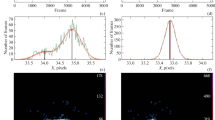Abstract
IN the flash kinetic method for investigating rapid photochemical reactions1, a reaction is initiated by a short flash of light and measured by a rapid-response photometer. Improvements of this method (refs. 2–5), particularly by the use of repetitive excitation followed by signal averaging, have increased the sensitivity of the method by a factor of about 100. Although the repetitive procedure eliminates the disturbance caused by statistically random signals, it does not remove disturbing signals related by a fixed phase to the flash sequence. In the study of the primary processes of photosynthesis such a false signal is caused by the fluorescence of chlorophyll, excited by the flashes, which interferes with a photometer signal in the same spectral range. This strong interference can be reduced by restricting the aperture and by electric compensation6,7. The rejection ratio which results, however, limits the sensitivity to a level far above that which might be normally obtained by repetitive signal evaluation5.
Similar content being viewed by others
References
Norrish, R. G. W., and Porter, G., Nature, 164, 658 (1949).
Witt, H. T., Moraw, R., and Müller, A., Z. Phys. Chem. N.F., 20, 193 (1959).
Rüppel, H., thesis, Univ. Marburg, Germany (1962).
Rüppel, H., Bültemann, V., and Witt, H. T., Ber. Bunsenges. Phys. Chem., 68, 340 (1964).
Rüppel, H., and Witt, H. T., in Methods in Enzymology, Fast Reactions (Academic Press, Inc., NY, in the press, 1968).
Döring, G., Stiehl, H.-H., and Witt, H. T., Z. Naturf., 22 B, 639 (1967).
Rüppel, H., Krog, U., and Witt, H. T., J. Electrochem. Soc., 107, 966 (1960).
Grau, G., Gürs, K., Müller, R., and Rosenberger, D., Z. Angew. Phys., 17, 16 (1964).
Kaminow, I. P., and Turner, E. H., Appl. Optics, 5, 1612 (1966).
Wolff, C., Buchwald, H.-E., Rüppel, H., and Witt, H. T., Naturwissenschaften, 54, 489 (1967).
Döring, G., Bailey, J. L., Kreutz, W., and Witt, H. T., Naturwissenschaften, 55, 220 (1968).
Anderson, I. M., and Boardman, N. K., Biochim. Biophys. Acta, 112, 403 (1966).
Author information
Authors and Affiliations
Rights and permissions
About this article
Cite this article
BUCHWALD, HE., RÜPPEL, H. Suppression of Disturbing Light Signals in Rapid Flash Kinetic Measurements. Nature 220, 57–58 (1968). https://doi.org/10.1038/220057a0
Received:
Revised:
Issue Date:
DOI: https://doi.org/10.1038/220057a0
- Springer Nature Limited
This article is cited by
-
Functional mechanism of water splitting photosynthesis
Photosynthesis Research (1991)
-
Methoden zur Aufl�sungssteigerung von Blitzlichtphotometern zur Untersuchung schneller chemischer Reaktionen
Fresenius' Zeitschrift f�r Analytische Chemie (1972)





